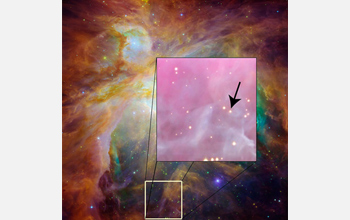All Images
News Release 08-104
Newly Born Twin Stars Are Far From Identical
NSF-funded basic research may cause astronomers to re-examine the masses and ages of young stars and star formation theories
This material is available primarily for archival purposes. Telephone numbers or other contact information may be out of date; please see current contact information at media contacts.

Twin stars observed in the Orion Nebula, a stellar nursery 1,500 light years from Earth. At this distance the twin stars appear as a single point of light. The observations were made with the NSF-supported SMARTS telescopes at the Cerro Tololo Inter-American Observatory in Chile, and with access provided by NSF to the Hobby-Eberly Telescope at the MacDonald Observatory in Texas.
Credit: NASA-JPL/HST and David James (Vanderbilt)
Download the high-resolution JPG version of the image. (523 KB)
Use your mouse to right-click (Mac users may need to Ctrl-click) the link above and choose the option that will save the file or target to your computer.
Keivan Stassun, associate professor of astronomy at Vanderbilt University, describes a surprising discovery--two very young twin stars in the Orion Nebula that have different temperatures, brightnesses and, probably, diameters. The finding could help scientists to develop a better understanding of how twin stars are born.
Credit: National Science Foundation / Vanderbilt University


